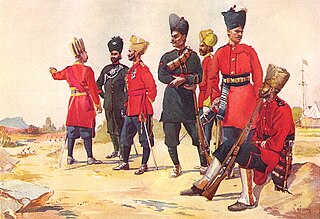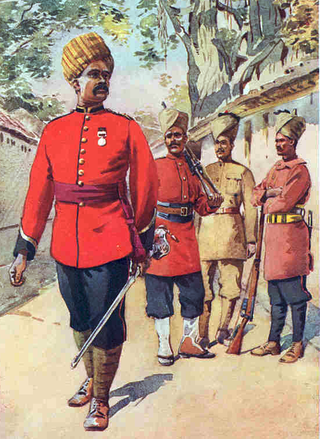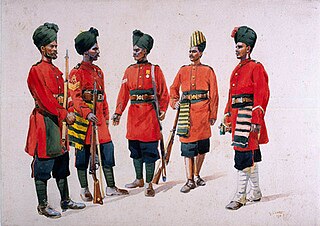Related Research Articles

The Kumaon Regiment is one of the oldest infantry regiments of the Indian Army. The regiment traces its origins to the 18th century and has fought in every major campaign of the British Indian Army and the Indian Army, including the two world wars, and is one of the highest decorated regiments of the Indian army.

The Deccan Horse or 9 Horse is one of the oldest and most decorated armoured regiments of the Indian Army. The Royal Deccan Horse , which was a regular cavalry regiment of the British Indian Army was formed from the amalgamation of two regiments after World War I. They saw service from the Mutiny of 1857 up to and including World War II.

The 82nd Punjabis was an infantry regiment of the British Indian Army. It was raised in 1788, as the 29th Madras Battalion. It was designated as the 82nd Punjabis in 1903 and became the 5th Battalion 1st Punjab Regiment in 1922. In 1947, it was allocated to the Pakistan Army, where it continues to exist as 4th Battalion The Punjab Regiment.
The 108th Infantry were an infantry regiment of the British Indian Army. The regiment traces their origins to 1768, when they were raised as the 1st Battalion, Bombay Sepoys.

The 112th Infantry were an infantry regiment of the East India Company's Bombay Army and later the British Indian Army. The regiment traces their origins to 1796, when they were raised as the 2nd Battalion, 6th Regiment of Bombay Native Infantry.
The 17th Infantry was an infantry regiment of the Bengal Army, later of the united British Indian Army. It was formed at Phillour in 1858 by Major J. C. Innes from men of the 3rd, 36th and 61st Bengal Native Infantry regiments who remained loyal to the British East India Company during the Indian Mutiny, and designated The Loyal Purbiah Regiment.
The 97th Deccan Infantry was an infantry regiment of the British Indian Army. They could trace their origin to 1794, when they were the 3rd Battalion of the Aurangabad Division in the Hyderabad State army. Which took part in the Battle of Seringapatam in the Fourth Anglo-Mysore War.
The 44th Merwara Infantry was an infantry regiment of the British Indian Army. They could trace their origins to 1824, when the Sylhet Light Infantry was raised. This first 44th eventually became the 44th Gurkhas and later 8th Gurkha Rifles.

The 83rd Wallajahbad Light Infantry was an infantry regiment originally raised in 1794 as the 33rd Madras Battalion, part of the Presidency of Madras Army which was itself part of the Honourable East India Company Army. The presidency armies, like the presidencies themselves, belonged to the East India Company until the Government of India Act 1858 transferred all three presidencies to the direct authority of the British Crown. In 1903 all three presidency armies were merged into the British Indian Army. The unit was disbanded before Indian Independence.
The 79th Carnatic Infantry was an infantry regiment of the British Indian Army. They could trace their origins to 1777, when the 20th Carnatic Battalion was raised from sub-units of the 1st, 3rd, 8th and 16th Carnatic Battalions.
The 86th Carnatic Infantry was an infantry regiment originally raised in 1794 as the 36th Madras Native Infantry, part of the Presidency of Madras Army which was itself part of the Honourable East India Company Army. The presidency armies, like the presidencies themselves, belonged to the East India Company until the Government of India Act 1858 transferred all three presidencies to the direct authority of the British Crown. In 1903 all three presidency armies were merged into the British Indian Army. The unit was disbanded before Indian Independence.
The 88th Carnatic Infantry were an infantry regiment of the British Indian Army. They could trace their origins to 1798, when they were raised as the 2nd Battalion, 14th Madras Native Infantry.
The 94th Russell's Infantry were an infantry regiment of the British Indian Army. They could trace their origins to 1813, when they were raised as the 1st Battalion of the Russell Brigade for the Princely state of Hyderabad. Until 1853, the regiment was part of the Nizam of Hydrabad's Army then after signing of a treaty with the then Governor General of India, The Nizam's Contingent was renamed as the Hyderabad Contingent and became part of the regular Indian Army.
The 95th Russell's Infantry were an infantry regiment of the British Indian Army. They could trace their origins to 1813, when they were raised as the 2nd Battalion of the Russell Brigade for the Princely state of Hyderabad. Until 1853, the regiment was part of the Nizam of Hydrabad's Army, then after signing of a treaty with the then Governor-General of India, The Nizam's Contingent was renamed as the Hyderabad Contingent and became part of the regular Indian Army.
The 98th Ahir Infantry was an infantry regiment of the British Indian Army. It could trace its origins to 1788, when it was raised as the 1st Battalion of the Ellichpur Brigade for the Princely state of Hyderabad. Until 1853, the regiment was part of the Nizam of Hydrabad's Army; then, after the signing of a treaty with the then Governor General of India, the Nizam's Contingent was renamed the Hyderabad Contingent and became part of the regular Indian Army.
The 99th Deccan Infantry were an infantry regiment of the British Indian Army. They could trace their origins to 1788, when they were raised as the 1st Battalion of the Ellichpur Brigade for the Princely state of Hyderabad. Until 1853, the regiment was part of the Nizam of Hydrabad's Army then after signing of a treaty with the then Governor General of India, The Nizam's Contingent was renamed as the Hyderabad Contingent and became part of the regular Indian Army.

The 110th Mahratta Light Infantry were an infantry regiment of the British Indian Army. The regiment traces their origins to 1797, when they were raised as the 2nd Battalion, 5th (Travancore) Regiment of Bombay Native Infantry.
The 121st Pioneers were an infantry regiment of the East India Company's Bombay Army and later the British Indian Army. The regiment traces their origins to 1777, when they were raised as the Marine Battalion.

The Nizam's Contingent, later Hyderabad Contingent, was the army funded by the Nizam of Hyderabad, the ruler of a Princely state of India.
References
- ↑ "Nanded District". maharashtra.gov. Retrieved 28 September 2009.
- ↑ Sumner p.15
- ↑ Quarterly Indian Army List January 1919, p. 1391
- Barthorp, Michael; Burn, Jeffrey (1979). Indian infantry regiments 1860-1914. Osprey Publishing. ISBN 0-85045-307-0.
- Rinaldi, Richard A (2008). Order of Battle British Army 1914. Ravi Rikhye. ISBN 978-0-9776072-8-0.
- Sharma, Gautam (1990). Valour and sacrifice: famous regiments of the Indian Army. Allied Publishers. ISBN 81-7023-140-X.
- Sumner, Ian (2001). The Indian Army 1914-1947. Osprey Publishing. ISBN 1-84176-196-6.
- Moberly, F.J. (1923). Official History of the War: Mesopotamia Campaign, Imperial War Museum. ISBN 1-870423-30-5
- Quarterly Indian Army List January 1919. Army Headquarters, India. Calcutta, 1919.